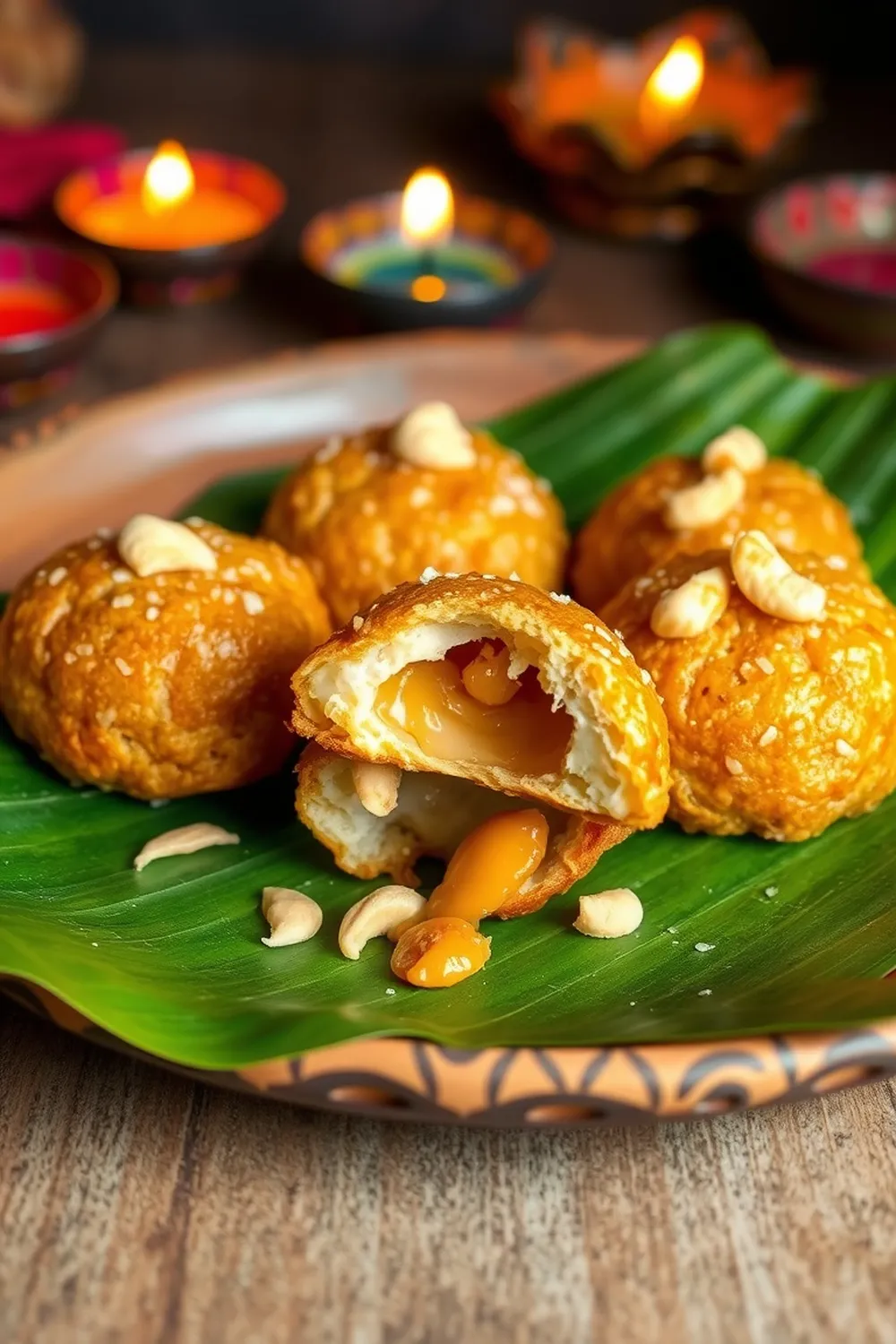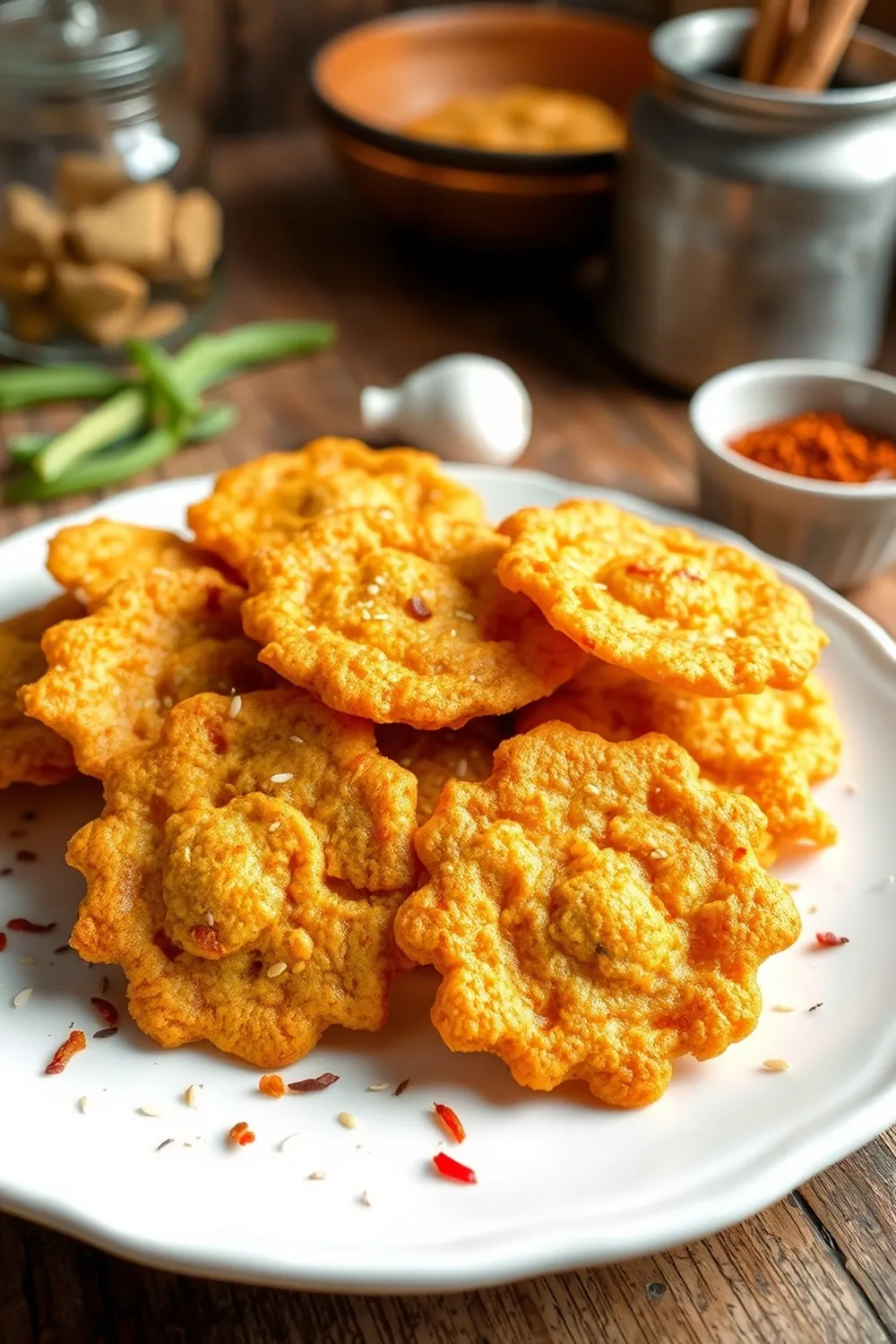- Prepare dough by mixing whole wheat flour, salt, and hot ghee. Gradually add water to knead into a firm yet pliable dough. Rest for 10-12 minutes.
- For filling, sauté fresh coconut in ghee for 2 minutes. Add cashews, raisins, jaggery, and cardamom. Cook briefly until jaggery melts. Cool completely.
- Roll dough into small circles. Place 1-2 tsp filling in the center, fold, and seal edges by pleating to prevent breakage during frying.
- Deep fry nevris in medium-hot oil until golden brown on both sides. Drain excess oil on paper towels before serving.
- Calories:180 kcal25%
- Energy:753 kJ22%
- Protein:2 g28%
- Carbohydrates:25 mg40%
- Sugar:12 mg8%
- Salt:50 g25%
- Fat:8 g20%
Last Updated on 6 months ago by Neha Deshmukh
Authentic Gujiya Recipe – Coconut & Cashew Filled Indian Sweet
Introduction
Oh, Gujiya! Just the name brings back so many childhood memories of Holi, and my grandmother patiently teaching me how to pleat the edges just right. This isn’t just a recipe; it’s a little piece of my heritage, and I’m so excited to share it with you. Gujiya are these delightful, semi-sweet, crescent-shaped pastries filled with a fragrant coconut and cashew mixture. They’re a labor of love, yes, but trust me – one bite and you’ll understand why they’re worth every minute!
Why You’ll Love This Recipe
This Gujiya recipe is all about capturing that authentic, homemade flavor. It’s flaky, subtly sweet, and bursting with the aroma of cardamom. Plus, I’ve included tons of tips and tricks to help you avoid common pitfalls (like bursting Gujiya – we’ve all been there!). Whether you’re making it for a festival, a special occasion, or just because you’re craving something delicious, this recipe will become a new favorite.
Ingredients
Here’s what you’ll need to create these little pockets of joy:
- 1 cup whole wheat flour (approx. 120g)
- 1.5 tablespoons ghee or oil (approx. 22ml)
- ????”??” cup water (approx. 180-200ml – start with less and add more as needed)
- ?? teaspoon salt (approx. 2-3g)
- 1 tablespoon ghee or oil (for stuffing – approx. 15ml)
- 1 cup freshly grated coconut (approx. 100g)
- ?? cup + 2 tablespoons grated jaggery (approx. 150g + 30g)
- ?? teaspoon cardamom powder (approx. ½ tsp – 1g)
- 7-8 cashews, chopped finely
- 19-20 golden raisins, chopped finely
Ingredient Notes
Let’s talk ingredients! A few little things can make a big difference:
- Whole Wheat Flour: I prefer using whole wheat flour (atta) for a slightly nutty flavor and rustic texture. You can also use all-purpose flour, but the atta gives it a lovely character.
- Ghee – clarifying process/regional variations: Ghee is traditional, and it adds a beautiful richness. If you don’t have ghee, any neutral oil will work. In some regions, people use a mix of ghee and oil for frying.
- Freshly Grated Coconut: Seriously, don’t skip this! Freshly grated coconut has a flavor that pre-shredded coconut just can’t match. It makes all the difference.
- Jaggery – types & substitutes: Jaggery (gur) is unrefined cane sugar, and it has a unique molasses-like flavor. Dark jaggery is more intense, while golden jaggery is milder. If you can’t find jaggery, you can substitute with brown sugar, but reduce the quantity slightly as brown sugar is sweeter.
- Cardamom Powder – sourcing & freshness: Good quality cardamom powder is key. Buy whole cardamom pods and grind them yourself for the freshest flavor. Store in an airtight container away from light and heat.
Step-By-Step Instructions
Alright, let’s get cooking!
- Make the Dough: In a large bowl, combine the whole wheat flour and salt. Add the ghee or oil and rub it into the flour with your fingertips until it resembles breadcrumbs. Gradually add water, a little at a time, and knead into a firm yet pliable dough. It shouldn’t be sticky!
- Rest the Dough: Cover the dough with a damp cloth and let it rest for 10-12 minutes. This allows the gluten to relax, making it easier to roll.
- Prepare the Filling: While the dough rests, heat the ghee or oil in a small pan. Add the grated coconut and sauté for 2 minutes until lightly golden.
- Add the Goodies: Add the chopped cashews, raisins, and grated jaggery to the pan. Cook briefly, stirring constantly, until the jaggery melts and everything is well combined.
- Spice it Up: Remove from heat and stir in the cardamom powder. Let the filling cool completely. This is important – warm filling will make the dough soggy.
- Shape the Gujiya: Divide the dough into small, equal-sized balls. Roll each ball into a small circle (about 3-4 inches in diameter).
- Fill & Seal: Place 1-2 teaspoons of the filling in the center of each circle. Gently fold the dough over to form a semi-circle. Pleat the edges to seal, ensuring there are no gaps to prevent bursting during frying. This takes practice, don’t worry if your first few aren’t perfect!
- Fry to Golden Perfection: Heat oil in a deep frying pan over medium heat. Carefully add the Gujiya, a few at a time, and fry until golden brown on both sides.
- Drain & Enjoy: Remove the Gujiya from the oil and drain on paper towels. Let them cool slightly before enjoying!
Expert Tips
- Don’t over-knead the dough, or it will become tough.
- Make sure the filling is completely cool before filling the Gujiya.
- Seal the edges really well to prevent bursting. A little water brushed along the edges can help.
- Fry at a moderate temperature. Too hot, and they’ll burn; too cold, and they’ll be oily.
Variations
Let’s get creative!
- Vegan Gujiya Adaptation: Substitute the ghee with a vegan butter alternative or coconut oil.
- Gluten-Free Gujiya Adaptation – flour alternatives: Use a gluten-free flour blend designed for baking. You might need to adjust the amount of water.
- Spice Level Adjustment – cardamom variations: My friend loves adding a pinch of nutmeg or mace to the filling for a warmer spice profile.
- Festival Adaptations – Holi specific tips: Traditionally, Gujiya are made in large batches for Holi. Get the whole family involved – it’s a fun activity!
Serving Suggestions
Gujiya are delicious on their own with a cup of chai. They also pair beautifully with a glass of cold milk or a scoop of vanilla ice cream.
Storage Instructions
Gujiya can be stored in an airtight container at room temperature for up to 3-4 days. They can also be frozen for longer storage.
FAQs
- What type of flour is best for Gujiya? Whole wheat flour (atta) is traditional and adds a lovely flavor, but all-purpose flour works too.
- Can I make the filling ahead of time? Absolutely! The filling can be made a day or two in advance and stored in the refrigerator.
- How do I prevent the Gujiya from bursting while frying? Seal the edges very well, and fry at a moderate temperature.
- What is the best way to seal the Gujiya edges? Practice makes perfect! Pleating the edges tightly is key. A little water brushed along the edges can help them stick.
- Can I use store-bought jaggery, or is freshly grated better? Store-bought jaggery is fine, but freshly grated jaggery has a more complex flavor.
Neha Deshmukh
Neha holds a B.A. in History with a focus on Indian and world history, including ancient, medieval, and modern periods. At RecipesOfIndia.org — the world’s largest database of Indian recipes — she combines her love for food and history by exploring how India’s past has shaped its culinary traditions.










